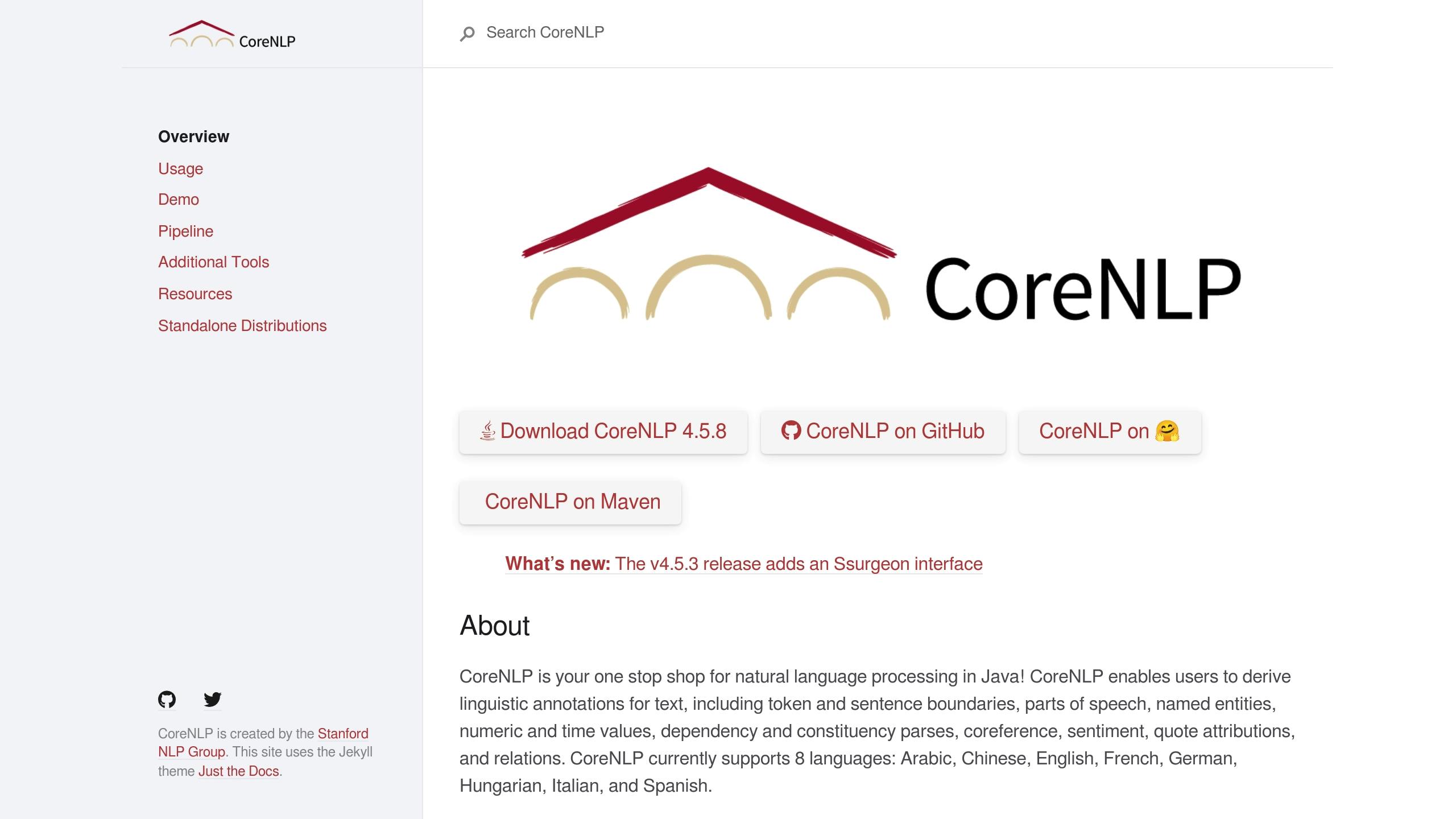
Top NLP Libraries for Voice Commands in LMS
Integrating voice commands into Learning Management Systems (LMS) can improve accessibility, student engagement, and ease of navigation. Here’s a quick overview of the top NLP libraries that make this possible:
- NLTK: Great for basic command processing and text analysis. Ideal for tasks like text classification, sentiment analysis, and multilingual input handling.
- spaCy: Known for speed and efficiency, it excels in processing transcribed voice commands with pre-trained models and word vectors.
- Stanford CoreNLP: Offers advanced features like coreference resolution and context recognition, making it suitable for complex educational tasks.
- Google Cloud Natural Language API: A cloud-based solution for real-time applications, offering robust syntax and sentiment analysis.
- QuizCat AI: Focused on creating interactive study tools like quizzes and flashcards from uploaded materials.
Quick Comparison
| Library | Key Features | Best Use Case |
|---|---|---|
| NLTK | Text classification, sentiment analysis | Course navigation |
| spaCy | Pre-trained models, dependency parsing | Large classes, fast processing |
| Stanford CoreNLP | Coreference resolution, multi-language | Complex content creation |
| Google Cloud NLP API | Real-time performance, sentiment analysis | Live sessions, cloud-based LMS |
| QuizCat AI | Quiz and flashcard generation | Personalized study aids |
These tools simplify voice command integration, making learning platforms more interactive and accessible.
AI Virtual Assistant with ChatGPT: Speech Recognition, NLP, and Text-to-Speech Integration
1. NLTK (Natural Language Toolkit)

NLTK is a Python-based library commonly used in education to process and analyze language. Its features make it a solid option for developing voice interfaces in Learning Management Systems (LMS).
Voice Command Processing Capabilities
NLTK's tools break down voice inputs into usable data. Here's how it helps:
- Text Classification: Categorizes voice commands effectively.
- Named Entity Recognition: Identifies course names and topics from spoken input.
- Sentiment Analysis: Detects the tone of interactions.
Integration with LMS Platforms
Since NLTK is Python-based and modular, it integrates smoothly with LMS platforms. Developers can build custom NLP components, like grammar rules tailored for educational needs, to interpret voice commands accurately.
Real-Time Applications: Key Points
Implementing NLTK in real-time systems requires testing for speed and scalability to ensure smooth performance.
Use Cases in Education
NLTK supports a variety of educational applications. For instance, it can process multilingual inputs, making it useful in language learning. It also enables interactive question-and-answer systems, enhancing engagement and learning outcomes in different educational environments.
2. spaCy

Building on NLTK's groundwork, spaCy brings a modern approach to NLP, making it a strong choice for voice-enabled Learning Management Systems (LMS).
spaCy is a ready-to-use NLP library designed for text analysis, ideal for interpreting transcribed voice commands in educational environments.
Tools for Processing Voice Commands
spaCy offers advanced features to handle transcribed voice inputs effectively:
- Neural Models: Comes with pre-trained models for various NLP tasks.
- Named Entity Recognition (NER): Identifies terms and concepts relevant to education.
- Dependency Parsing: Analyzes relationships between words in a sentence.
- Word Vectors: Helps detect semantic similarities to improve comprehension.
Seamless LMS Integration
Since spaCy is built with Python, it can be integrated with LMS platforms through custom pipelines that cater to specific educational requirements.
Combining spaCy with Speech-to-Text
While spaCy doesn’t process voice commands directly, pairing it with speech-to-text tools creates efficient voice-enabled learning systems, making educational resources more accessible.
sbb-itb-1e479da
3. Stanford CoreNLP

Stanford CoreNLP is a Java-based NLP toolkit designed to handle complex text and voice processing tasks. It's particularly useful for managing voice commands in Learning Management Systems (LMS) and supports multiple languages.
Voice Command Processing Features
Stanford CoreNLP includes:
- Part-of-Speech Tagging: Identifies the grammatical roles of words in user commands.
- Named Entity Recognition: Detects key terms like course titles and academic concepts.
- Sentiment Analysis: Understands the emotional tone and intent behind voice commands.
- Coreference Resolution: Maintains context across different voice interactions.
LMS Integration Options
CoreNLP's Java architecture makes it compatible with various LMS platforms. Integration methods include:
| Integration Method | Key Features | Ideal For |
|---|---|---|
| REST API | Works across platforms and supports scalability | Large-scale educational institutions |
| Java SDK | Offers direct, high-performance integration | Custom-built LMS systems |
| Docker Container | Simplifies deployment in isolated environments | Cloud-based learning platforms |
Real-Time Performance Optimization
Thanks to its modular design, CoreNLP allows you to load only the components you need. This reduces resource usage, making it well-suited for real-time voice processing in virtual classrooms and online education platforms.
Applications in Education
Stanford CoreNLP supports a wide range of educational scenarios, such as:
- Virtual Classroom Management: Processes voice commands for attendance and student engagement.
- Content Navigation: Enables natural language searches through course materials.
- Accessibility Enhancements: Improves assistive learning tools with advanced language processing.
- Assessment Tools: Allows for voice-activated quiz administration and grading.
Up next, we'll look at additional NLP libraries that can further enhance voice command functionality in LMS platforms.
4. Google Cloud Natural Language API

Google Cloud Natural Language API is a cloud-based NLP solution that offers a flexible alternative to traditional on-premise tools. It provides powerful features tailored for processing voice commands in Learning Management Systems (LMS).
Voice Command Processing Capabilities
The API supports several advanced functions, including:
- Entity Analysis: Recognizes academic subjects and course titles.
- Syntax Analysis: Breaks down command structures to extract actionable information.
- Sentiment Analysis: Assesses tone and user engagement levels.
- Content Classification: Categorizes educational content effectively.
Integration with LMS Platforms
You can integrate the API using RESTful services, client libraries (available for Python, Java, and Node.js), or Cloud Functions, making it versatile for various development environments.
Performance in Real-time Applications
Thanks to its global cloud infrastructure, the API ensures quick response times and can manage large-scale interactions with minimal delays, making it ideal for real-time educational scenarios.
Tailored for Educational Needs
The API’s models are designed to understand educational terminology, making it a great fit for interactive classroom tools, accessibility enhancements, and administrative workflows. Its ability to refine voice command interactions adds another layer of functionality to LMS platforms, complementing the features of other NLP libraries.
5. QuizCat AI

QuizCat AI takes study materials to the next level by turning them into interactive and engaging learning tools.
This tool enhances learning management systems (LMS) by transforming uploaded materials into quizzes, flashcards, and even podcasts. It’s designed to make studying more personalized and effective for both students and educators.
How It Works: Material Transformation and Integration
QuizCat AI can process files like PDFs, DOCX, and TXT documents, converting them into interactive study aids. Its REST API makes it simple to integrate into existing LMS platforms, adding new functionality without requiring a complete system overhaul.
What Can QuizCat AI Do?
QuizCat AI supports a variety of educational needs, including:
- Content Creation: Turns notes into well-structured resources that help with exam prep and understanding key concepts.
- Custom Assessments: Generates quizzes and flashcards tailored to the material, making it easier for students to review and retain information.
- Flexible Learning Options: Converts study materials into podcasts and other formats, allowing students to learn on their own schedule.
With over 400,000 students already using it, QuizCat AI combines AI-powered content creation with strong data security. Its encryption protocols ensure that user data and study materials are protected, making it a reliable choice for schools and institutions.
QuizCat AI modernizes how we study by bringing interactive, tech-driven tools into the classroom.
Summary and Next Steps
NLTK remains a go-to choice for its extensive linguistic tools. spaCy stands out for its speed and efficiency, offering pre-trained models ideal for specialized tasks. Stanford CoreNLP is tailored for educational purposes, while Google Cloud Natural Language API provides powerful cloud-based processing.
These tools pave the way for advancements in voice-enabled learning.
Exploring these libraries highlights trends shaping the future of LMS voice commands:
- Multimodal Learning
- Adaptive Learning Systems
- Improved Accessibility
Modern LMS platforms like QuizCat AI - used by over 400,000 students - showcase how NLP integration can transform interactive learning.
| Feature | Primary Use Case | Best-Suited Library |
|---|---|---|
| Basic Command Processing | Course Navigation | NLTK |
| Real-time Interaction | Live Sessions | Google Cloud Natural Language API |
| Complex Language Analysis | Content Creation | Stanford CoreNLP |
| High-Speed Processing | Large Classes | spaCy |
Research shows that voice-enabled features increase student engagement, opening doors to more tailored learning experiences and streamlined assessments.
